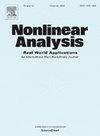Bifurcation and dynamics of periodic solutions of MEMS model with squeeze film damping
IF 1.8
3区 数学
Q1 MATHEMATICS, APPLIED
引用次数: 0
Abstract
In this paper, we study the oscillations of an idealized mass–spring model of micro-electro-mechanical system (MEMS) with squeeze film damping. The model consists of two parallel electrodes separated by a gap : one of them is fixed, and another one is movable and attached to a linear spring with stiffness coefficient . The oscillation, under the influence of AC–DC voltage , is ruled by the following singular differential equation Here, is the vertical displacement of the moving plate ( is always assumed to be less than ), is its mass, is the electrode area, and is the absolute dielectric constant of vacuum. Taking as the parameter, we show the existence of saddle–node bifurcation of -periodic solutions to the equation in the parameter space. This answers, from certain point of view, the open problem proposed by Torres in his monograph, see Torres (2015, Open Problem 2.1, p. 18). Further, we prove that the equation has exactly two classes of -periodic solutions: as tends to , one of them uniformly tends to at the rate of , while the minimum values of the second class tend to, or cross, 0.
带挤压膜阻尼的微机电系统模型周期解的分岔与动力学
本文研究了具有挤压膜阻尼的微机电系统(MEMS)理想化质量弹簧模型的振荡。该模型由两个平行电极组成,两电极之间有间隙 d:其中一个固定,另一个可移动,并连接到刚度系数为 k>0 的线性弹簧上。在交直流电压 V(t)=vdc+vaccos2πTt 的影响下,振荡受以下奇异微分方程 my′′+[A(d-y)3+Ad-y]y′+ky=θ0A2V2(t)(d-y)2 的支配。这里,y 是移动板的垂直位移(y 始终假定小于 d),m>0 是移动板的质量,A>0 是电极面积,θ0>0 是真空的绝对介电常数。以 d 为参数,我们证明了方程在参数空间中存在 T 周期解的鞍节点分岔。这从某种角度回答了托雷斯在其专著中提出的开放问题,见托雷斯(2015,开放问题 2.1,第 18 页)。此外,我们还证明了方程正好有两类 T 周期解:当 d 趋于 +∞ 时,其中一类以 d 的速率均匀地趋于 +∞,而第二类的最小值趋于或越过 0。
本文章由计算机程序翻译,如有差异,请以英文原文为准。
求助全文
约1分钟内获得全文
求助全文
来源期刊
CiteScore
3.80
自引率
5.00%
发文量
176
审稿时长
59 days
期刊介绍:
Nonlinear Analysis: Real World Applications welcomes all research articles of the highest quality with special emphasis on applying techniques of nonlinear analysis to model and to treat nonlinear phenomena with which nature confronts us. Coverage of applications includes any branch of science and technology such as solid and fluid mechanics, material science, mathematical biology and chemistry, control theory, and inverse problems.
The aim of Nonlinear Analysis: Real World Applications is to publish articles which are predominantly devoted to employing methods and techniques from analysis, including partial differential equations, functional analysis, dynamical systems and evolution equations, calculus of variations, and bifurcations theory.

 求助内容:
求助内容: 应助结果提醒方式:
应助结果提醒方式:


